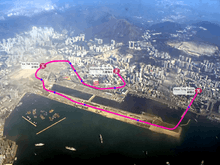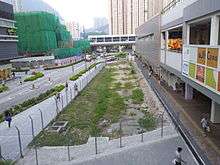Environmentally Friendly Linkage System
| Environmentally Friendly Linkage System | |
|---|---|
 Proposed alignment of the monorail overlaid on a 2009 photo | |
| Overview | |
| Other name(s) | Kai Tak Monorail |
| Native name | 環保連接系統 |
| Status | Proposed |
| Locale | New Kowloon |
| Termini |
Kowloon Bay Station Kwun Tong Station |
| Stations | 12 |
| Website |
www |
| Operation | |
| Planned opening | 2023 |
| Character | Elevated and grade-separated |
| Depot(s) | Site of the current Kowloon Bay Vehicle Examination Centre |
| Technical | |
| Line length | 9 km (5.6 mi) |

The Environmentally Friendly Linkage System (Chinese: 環保連接系統), abbreviated to EFLS and commonly called the Kai Tak Monorail, is a government-proposed monorail system in the Kai Tak Development area, Hong Kong[1] with 12 stations. The system's construction was estimated to start in 2018 for completion in 2023.[2][3] The new links are expected to account for 15 percent of public transportation in the Kowloon East Development. The system is expected to cost $12 billion Hong Kong dollars.[4]
History
Throughout the 1990s, a number of master plans were drawn up to prepare for the eventual reuse of the Kai Tak airport land. The South East Kowloon Development Statement (1993) and the Feasibility Study for South East Kowloon Development (1998) both proposed that the site be served by two conventional Mass Transit Railway lines running underground.[5][6] A 2001 study deleted the line serving the former runway area, replacing it with a proposed "trolley bus or light rail".[7] In light of the Protection of the Harbour Ordinance and overwhelming public opinion against further reclamation of Victoria Harbour, the plan for Kai Tak was further cut back. But this basic premise of a light railway linking the Sha Tin to Central Link station to the runway hinterland lives on in the monorail proposal.
In 2007, the Kai Tak Outline Zoning Plans with railway connection system was approved by the Executive Council.
The EFLS project was headed by the Development Bureau with public consultation carried out by the Civil Engineering and Development Department.
The Civil Engineering and Development Department appointed consultants to review the flexibility of the EFLS.
According to the 2011-2012 Policy Address, Kowloon East would become the city's second Central Business District.
Technology debate
Hong Kong Tramways Limited proposed building a modern tramway, instead of a monorail, on the grounds of lower construction cost, more affordable fares, lower operating cost, improved flexibility for future extensions, less visual impact, no noise pollution, and socio-economic benefits. Norman Y. S. Heung, project manager from the Civil Engineering and Development Department, responded that it would not be acceptable for a tramway to share ground space with cars.[8] Emmanuel Vivant, general manager of Hong Kong Tramways, responded that "in a city that rightly prides itself on putting priority on public transport, and where only 10 per cent of trips are done by private car, it should not be impossible to allocate space to tram lanes that can each carry eight times as many people as a road lane" and that "promoting usage of emission-free modern tramways rather than polluting private cars, would be a perfectly sensible policy decision. Where necessary, the modern tramway can simply share space with other road users".[9]
The need for heavy construction of any kind has been challenged by the Hong Kong Cycling Alliance, on the basis that the 13-kilometre cycling network already planned for the area provides viable and more flexible connectivity, at much lower environmental impact.[10]
The South China Morning Post claimed that a "green bus network" would only cost up to HK$400 million, and could still make a profit.[11]
Finances
The cost of construction at 2010 prices is $12 billion Hong Kong dollars. The patronage is expected to hit 200,000 by 2031, according to the government.[4] In 2012 officials estimated that building a monorail would yield a return of one per cent, versus four per cent for a conventional railway.[11] The Post reported that the system would break even only if the government bears the capital and asset replacement costs.[11]
Stations
The MTR walk‐in catchment coverage has usually a 500-metre radius or less than 8-minute walking time. After considering estimated passenger and fire safety issues, the Civil Engineering and Development Department takes the MTR walk-in catchment coverage as an indicator for the selection of the EFLS station site.
| English name | Chinese name | District | Interchange | Opening date |
|---|---|---|---|---|
| Environmentally Friendly Linkage System | ||||
| Kowloon Bay Station | 九龍灣總站 | Kwun Tong District | MTR Kwun Tong Line | Expected 2023 |
| Hoi Bun Road Station | 海濱道站 | |||
| Kowloon Bay Business Area Station | 九龍灣商貿區站 | |||
| Kai Cheung Road Station | 啟祥道站 | |||
| Richland Gardens Station | 麗晶花園站 | |||
| Station Square Station | 車站廣場站 | Kowloon City District | MTR Kai Tak Station | |
| Stadium Station | 體育場館站 | |||
| Metro Park Station | 都會公園站 | |||
| Runway Precinct Station | 跑道休閒區站 | |||
| Cruise Terminal Station | 郵輪碼頭站 | |||
| Kwun Tong Ferry Pier Station | 觀塘碼頭站 | Kwun Tong District | Ferry to North Point | |
| Kwun Tong Station | 觀塘站 | MTR Kwun Tong Line | ||
Rolling stock
At this time, the government plans to use two-car monorail trains with capacities of about 250 passengers. The stations would be designed to allow for future expansion to three-car trains.[4]
References
- ↑ 政府擬建高架鐵路連接九龍東不同地點
- ↑ 林鄭月娥指啟德鐵路如經新蒲崗土瓜灣將降低回報率
- ↑ 林鄭月娥指啟德高架鐵路工程不應只著眼於回本
- 1 2 3 "Study Overview". Environmentally Friendly Linkage System. Civil Engineering and Development Department. Retrieved 14 December 2015.
- ↑ "South East Kowloon Development Statement Executive Summary" (PDF). Planning Department. September 1993.
- ↑ "Feasibility Study for South East Kowloon Development" (PDF). Planning Department. November 1998.
- ↑ "Comprehensive Feasibility Study for the Revised Scheme of South East Kowloon Development" (PDF). Territory Development Department. October 2001.
- ↑ Heung, Norman Y. S. (7 May 2013). "Tram system not feasible". South China Morning Post.
- ↑ Vivant, Emmanuel (16 May 2013). "Tramways a pollution-free option". South China Morning Post.
- ↑ Transport Bureau misses another chance, Hong Kong Cycling Alliance
- 1 2 3 Cheung, Chi-fai (11 April 2012). "Kai Tak monorail won't stretch into nearby districts". South China Morning Post. p. 3.
External links
| Wikimedia Commons has media related to Environmentally Friendly Linkage System. |